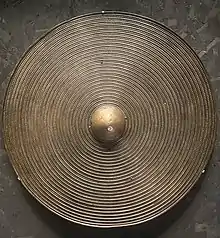| Moel Hebog shield | |
|---|---|
| Tarian Moel Hebog | |
 Moel Hebog shield. Wales, 1300–1000 BC. On display at the British Museum. | |
| Material | Welsh sheet-bronze |
| Discovered | 1300–1000 BC |
| Present location | British Museum |
The Moel Hebog shield (Welsh: Tarian Moel Hebog) or Moel Siabod shield[1] is a large copper-alloy Yetholm-type shield from Bronze Age Britain, found in Wales in 1784, and now in the British Museum in London. It dates from 1300–1000 BC.
Description

The late Bronze Age shield was found in a bog near Moel Hebog mountain in 1784, near Beddgelert. It is now in the British Museum's collection.[2][3][4] Other sources point to a finding on Moel Siabod.[1][5]
Richard Blurton wrote of the shield in the book The Enduring Image: Treasures from the British Museum, "This shield is a splendid example, representative of the rise of large sheet-bronze work in later Bronze Age Europe. Much effort was directed towards the production of ceremonial metal armour indicating the prevalence of the idea of man as a warrior."[6]
There have been calls for the artefact to be returned to Wales.[7]
See also
References
- 1 2 "Bronze Age Shield - Findspot, Moel Siabod (512940)". Coflein. RCAHMW. Retrieved 18 January 2023.
- ↑ "shield | British Museum". The British Museum. Retrieved 18 January 2023.
- ↑ "Buried treasure: calls for important Welsh artefacts to be brought back home". Nation.Cymru. 25 September 2021. Retrieved 14 July 2022.
- ↑ A short account of Caernarvon, and Bedd-kill-hart, or, Beddgelart. 1806. p. 25.
- ↑ Walford, Edward; Cox, John Charles; Apperson, George Latimer (1911). The Antiquary. E. Stock. p. 63.
- ↑ Blurton (1997). The Enduring Image: Treasures from the British Museum.
- ↑ "Buried treasure: calls for important Welsh artefacts to be brought back home". Nation.Cymru. 25 September 2021. Retrieved 10 February 2022.
